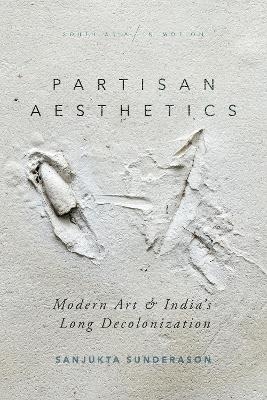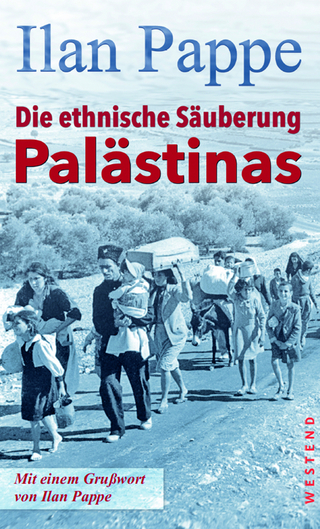
Partisan Aesthetics
Stanford University Press (Verlag)
978-1-5036-1194-8 (ISBN)
Partisan Aesthetics explores art's entanglements with histories of war, famine, mass politics and displacements that marked late-colonial and postcolonial India. Introducing "partisan aesthetics" as a conceptual grid, the book identifies ways in which art became political through interactions with left-wing activism during the 1940s, and the afterlives of such interactions in post-independence India. Using an archive of artists and artist collectives working in Calcutta from these decades, Sanjukta Sunderason argues that artists became political not only as reporters, organizers and cadre of India's Communist Party, or socialist fellow travelers, but through shifting modes of political participations and dissociations. Unmooring questions of Indian modernism from its hitherto dominant harnesses to national or global affiliations, Sunderason activates, instead, distinctly locational histories that refract transnational currents. She analyzes largely unknown and dispersed archives—drawings, diaries, posters, periodicals, and pamphlets, alongside paintings and prints—and insists that art as archive is foundational to understanding modern art's socialist affiliations during India's long decolonization. By bringing together expanding fields of South Asian art, global modernisms, and Third World cultures, Partisan Aesthetics generates a new narrative that combines political history of Indian modernism, social history of postcolonial cultural criticism, and intellectual history of decolonization.
Sanjukta Sunderason is Assistant Professor at the Leiden University Institute for Area Studies, the Netherlands.
Contents and AbstractsPostscript: Toward an Aesthetics of DecolonizationIntroduction: Partisan Aesthetics: Configurations chapter abstractThe introductory chapter configures the book's foundational concept of "partisan aesthetics." Entering through historical conjuncture of the Bengal famine of 1943 and the longue durée shadows of the climactic 1940s, it explores how art became political, not through deterministic political content but through mediations of experiences, displacements, and memory via art's aesthetic dimensions. It shows how early twentieth-century aesthetic conflict between "Indian-style" and "western-style" art generated new values and vocabularies of realism, the modern, the social, the popular, and the progressive, and how these artistic dynamics converged with a growing left-wing cultural movement beginning in the late 1930s. Partisan aesthetics developed both through dialogues and dissonances between art and the left in the 1940s, and the sociopolitical and ideological displacements of this moment in post-partition India.
Chapter 1: "Political Potentiality": Jamini Roy and the Formations of Progressive Art Criticism chapter abstractThe first chapter studies a series of essays on the art of Jamini Roy written between 1937 and 1944, not by art critics but by modernist poets, writers, academics, and socialist fellow-travelers, who gathered around the Bengali critical review journal Parichoy. The essays interpreted Roy's folk-modern idiom of pat or scroll paintings from modernist, sociological, and, increasingly, quasi-socialist vocabularies. In the process, they generated a hitherto unknown discursive space for "progressive" art and art criticism that captured an early socialist assimilation of modernist art, and values of formalism with socialism. They reveal, in otherwise dispersed ways, a "passive participation" of art in a growing left-wing culture, where critics were keen on identifying the political "potentiality" of artistic form rather than its active political commitment as the underground Communist Party of India (CPI) allowed for more informal and ambiguous forms of political affiliations.
Chapter 2: "As Agitator and Organizer": Socialist Realism and Artist-cadres of the Communist Party of India chapter abstractThe second chapter studies the artists committed to the Communist Party of India during war, famine, and popular resistance in the 1940s, and the "active authorship" of socialist visual reportage that they pioneered. In their works, a peculiarly late-colonial formation of socialist realism can be traced, one that combined expressionistic images of hunger with revolutionary potentialities of labor. As artist-cadres of the party like Chittaprosad and Somnath Hore visually documented the Bengal famine, peasant movements, party conferences, and peasant congresses, the party developed a complex and contradictory cultural policy: it deployed its artist-cadres as collectors of "raw material," while seeking to assimilate via art critical writings, artists outside the party fold within an expanding scope of socialist realist art.
Chapter 3: "Concrete Contextuality": Realism and Its Discontents in the Art of the Calcutta Group chapter abstractThe third chapter focuses on an artist collective outside the fold of the Communist Party of India that the party sought to draw into its fledging cultural movement in the 1940s. The Calcutta Group of artists came into being during the year of the Bengal famine, 1943, with a self-proclaimed mission of developing a modern idiom of art rooted in social reality. In their decade-long tenure, they both aligned with and deviated from the left's rhetoric of socialist art, while carving out a new dialogical field of modernism and realism. These "vacillating affiliations" of the group to ideas of the social and the socialist, along with the shifting art discourse around them, particularly after Indian independence in 1947, reveals both the left's anxious trysts with modern art and ideological subtexts of the de-radicalization of vocabularies of progressive art at the arrival of Nehruvian political modernity.
Chapter 4: "All the More Real for Not Being Preached": Forms and Futures of Socialist Art in Nehruvian India chapter abstractThe fourth chapter follows the afterlives of left-wing cultural movement of the 1940s in Nehruvian India. What happened to the visual rhetorics of this radical aesthetics once the anti-imperial struggle was transformed? What forms did socialist art take once the high noon of the cultural movement had passed? In the late 1940s, as the left's cultural movement dissipated under a change of guard within the Communist Party, art discourse in Nehruvian India reformulated the radical vocabulary of socialist art into new, de-radicalized values of democratic art and the citizen-artist. Studying new forms of socialist art and art discourse as well as conflicted reception of the values of humanism, democratic art, and socialist realism during the 1950s and early 1960s, this chapter makes critical connections between the communist aesthetic, the Nehruvian national-popular aesthetic, and Cold War cultural values in the post-colony.
Chapter 5: "Revolution in the Tropics, Love in the Tropics": Arts of Displacement in the Post-colony chapter abstractThe postscript returns to the key propitiations of the book that constitute the parameters of the concept of partisan aesthetics. It reiterates the methodological significance of locational analysis to nuance the historicities and possibilities of the political in the artistic modernity of the post/colony. It proposes that from the "irregular" histories of art and the left during India's long decolonization, two potential directions in historiography can be pursued: first, trans-border histories of artistic modernities in post-1947 South Asia via questions of history, memory, and the locational trails of decolonization; and second, a transnational connected history of art and decolonization across the Global South via the artistic negotiations of displacements that a retreating empire produced. The book closes with an open-ended question: What histories emerge if twentieth-century Indian art is examined through its contradictions and out-of-sync moments?
| Erscheinungsdatum | 04.06.2020 |
|---|---|
| Reihe/Serie | South Asia in Motion |
| Zusatzinfo | 31 halftones |
| Verlagsort | Palo Alto |
| Sprache | englisch |
| Maße | 152 x 229 mm |
| Themenwelt | Kunst / Musik / Theater ► Kunstgeschichte / Kunststile |
| Sachbuch/Ratgeber ► Geschichte / Politik ► Allgemeines / Lexika | |
| Geisteswissenschaften ► Geschichte ► Regional- / Ländergeschichte | |
| Geschichte ► Teilgebiete der Geschichte ► Kulturgeschichte | |
| ISBN-10 | 1-5036-1194-9 / 1503611949 |
| ISBN-13 | 978-1-5036-1194-8 / 9781503611948 |
| Zustand | Neuware |
| Informationen gemäß Produktsicherheitsverordnung (GPSR) | |
| Haben Sie eine Frage zum Produkt? |
aus dem Bereich


